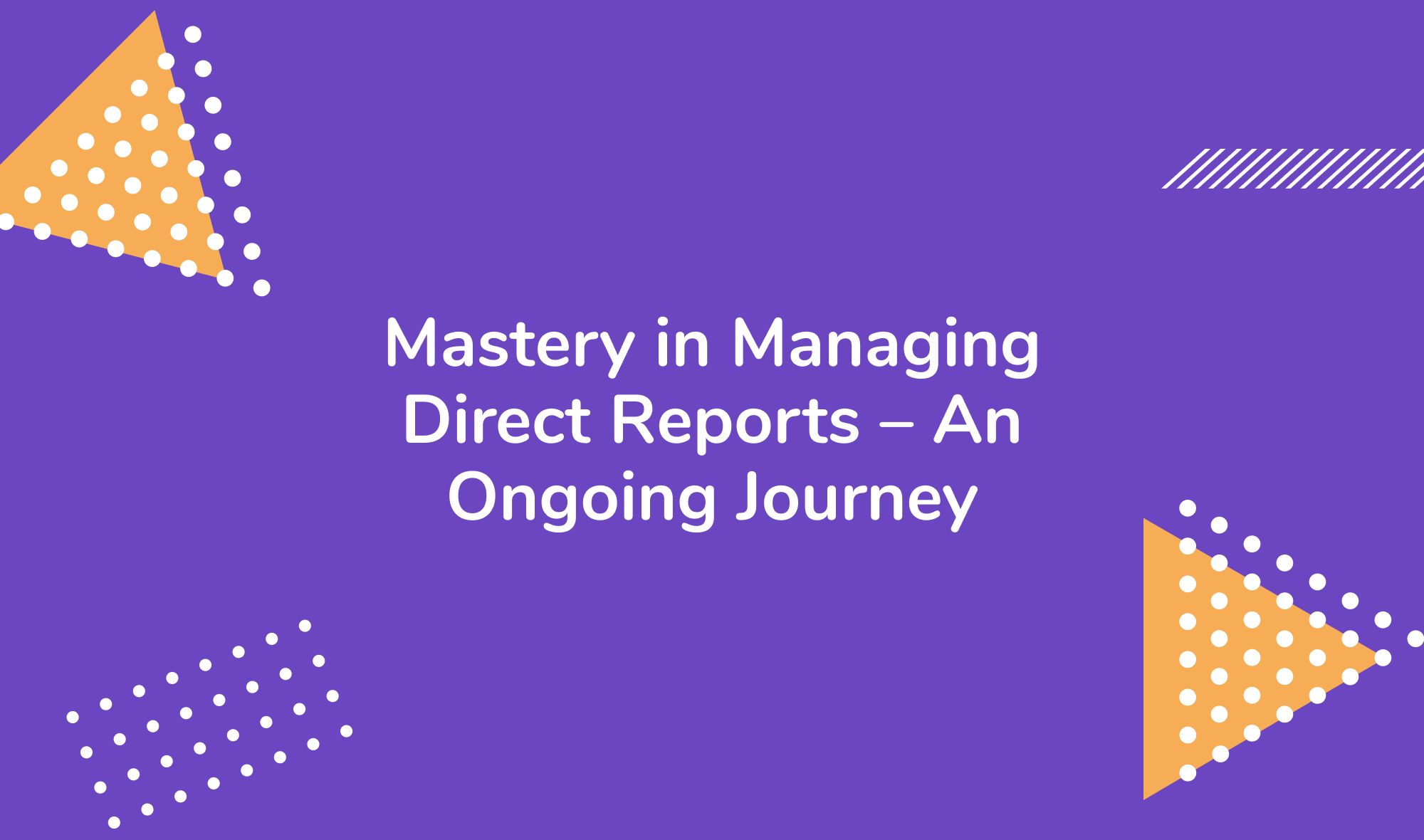Mastering the Art of Managing Direct Reports
By Remy Meraz • July 31, 2023
Key Takeaways
- Direct and indirect reports play a pivotal role in an organization's structure and overall performance.
- Open, consistent communication is key to building trust and engagement with direct and indirect reports.
- Performance evaluations are vital tools in managing direct reports, fostering growth, and identifying areas for improvement.
- Understanding the different tiers of management helps in effectively managing direct and indirect reports.
- Continuous learning and adaptation are vital in mastering the management of direct reports.

In today's dynamic business landscape, navigating the intricate maze of the organizational hierarchy is a fundamental skill for any manager. A critical part of this involves managing your direct reports effectively. In every organizational structure, the direct report dynamic significantly influences productivity, company culture, and overall performance.
Are you wondering about how many direct reports are too many? Or perhaps you're curious about the crucial differences between direct reports and indirect reports? As a manager, team leader, or department head, these questions are not just relevant, they're paramount to the successful running of your team or department.
But managing direct reports is no easy task. It requires a delicate balance of clear and consistent communication, constructive feedback, and performance evaluations. This not only involves understanding the formal structure presented in the organizational chart, but also the informal relationships and dynamics that shape everyday interactions within the team.
Through this post, we'll explore the nuanced world of direct reports and indirect reports, the average number of direct reports a manager should have, and how to best handle the responsibility that comes with these roles. In this journey, you will learn to effectively manage your direct reports, develop an inclusive leadership style, and build a team that drives your business strategy forward.
Here, at Zella Life, we're passionate about providing the tools and resources to empower you to become the best leader you can be. Let's dive into mastering the art of managing direct reports.
Join our Newsletter
Transform your career with our personal growth insights. Get one valuable tip right in your inbox every Saturday morning.
What is a Direct Report? Exploring the Meaning
In the realm of management, the term direct report refers to an employee who reports directly to a supervisor or manager. These direct reportees are usually next in the hierarchical line, reporting to their manager about performance, issues, and accomplishments.
Their role within the organizational structure and business strategy is pivotal. It's through this clear line of reporting that managers can effectively execute plans, monitor progress, and make strategic decisions.
These direct reports provide the vital link between the broader organizational strategy and the work that gets done on the ground. If you'd like to learn more about how direct reports play into your business, feel free to explore our business coaching offerings at Zella Life.
The Responsibility of Handling Direct Reports

When you take on the role of a manager, you’re not just responsible for your own work; you become responsible for the work of your direct reports. This involves a broad spectrum of duties:
- Providing clear communication and direction: Your direct reports rely on you for clarity about their roles, objectives, and the ways in which their work contributes to the broader business strategy.
- Performance Evaluations: As a manager, you're responsible for evaluating the work of your direct reports, which includes conducting performance reviews and providing constructive feedback.
- Professional Development: Part of managing direct reports includes helping them to develop new skills, providing opportunities for growth, and supporting their career progression.
Join our Newsletter
Transform your career with our personal growth insights. Get one valuable tip right in your inbox every Saturday morning.
A common question among managers is "how many direct reports should I handle?" While there's no one-size-fits-all answer, a good rule of thumb is to have no more direct reports than you can effectively manage and support. Remember, the goal is not to amass a large number of direct reports, but to create an environment that fosters productivity, growth, and satisfaction. Read more about this delicate balance in our blog post on overcoming perfectionist disorder.
Indirect Reports: The Unseen but Essential Part of the Structure

In a hierarchical organizational structure, indirect reports are those employees who don't report directly to a manager but rather, are supervised by one of the manager's direct reports. These indirect reportees play an often overlooked, yet critical role in maintaining the structure and function of an organization.
Although these employees don't report directly to a senior manager or department head, managing their work is crucial. This involves oversight through your direct reports and ensuring the alignment of their work with the broader business goals. Understanding the work of your indirect reports is necessary for a complete picture of your team's overall performance.
The Art of Communication: Building Trust with Direct and Indirect Reports

In any leadership role, open communication is the bedrock of trust and productivity. This involves regular check-ins with your direct reports, team meetings, and even casual conversations. Keeping a clear line of communication builds trust, encourages employee engagement, and fosters a collaborative environment.
If you're looking to create a better workplace culture that supports effective management of direct reports, check out our recent post on identifying and correcting negative workplace culture.
It's not enough to just have one on one meetings with your direct reports or send out team emails. Consistent communication involves a variety of channels and styles to meet the needs and preferences of your diverse team. Whether you're a team leader or a vice president, ensuring your direct reports and indirect reports feel heard and valued is a critical aspect of your role.
If you're looking to make your meetings even more effective, check out our blog post on effective meetings for some valuable tips.
And communication isn't just about conveying information; it's also about listening. By inviting and valuing feedback, you can create an environment where your direct reportees feel comfortable voicing their ideas, concerns, and aspirations. This feedback can prove invaluable in steering the course of your team and organization.
Get deeper insights on how to handle conflicts and improve communication in our blog post on constructive conflict.
Performance Evaluations: A Key in Managing Direct Reports

Performance evaluations are instrumental in effectively managing your direct reports. It's an opportunity for a manager to assess their direct report's work performance, provide constructive feedback, and set goals for future growth. Evaluations can also highlight areas for improvement, not just in the direct report's work but also in the overall team dynamics.
A successful performance evaluation is built on the relationship between the manager and the direct report. An environment of trust and open communication allows for candid conversations and more effective feedback. The key is to use evaluations as a tool for growth, focusing on both the strengths and areas for improvement of your direct reportee.
For a deeper understanding of the power of knowing what you don't know, consider reading "Think Again: The Power of Knowing What You Don't Know" by Adam Grant.
The Organizational Ladder: Navigating Direct and Indirect Reports

Organizational hierarchies often involve different tiers of management, including team leaders, department heads, and senior managers. Each of these roles comes with varying levels of responsibility for direct reports and indirect reports.
For instance, team leaders may have a handful of direct reports and focus more on the day-to-day operations of the team. In contrast, department directors and senior managers often oversee several teams, thus dealing with more indirect reports. Understanding these different tiers and their interactions with direct and indirect reports is crucial to effectively navigate the organizational structure.
For a deeper dive into what separates good companies from great ones, and how this relates to leadership and management, consider reading "Good to Great: Why Some Companies Make the Leap and Others Don't" by Jim Collins.
Conclusion: Mastery in Managing Direct Reports – An Ongoing Journey

Managing direct reports is a critical skill in any leadership role. Effective management of direct reports and indirect reports not only leads to an efficient team but also fosters a positive work culture and drives the overall performance of the organization.
The journey to mastery in managing direct reports is ongoing. Every direct reportee is different, and thus, so should be your management style. Continuous learning and adaptation, keeping pace with the evolving dynamics of the workplace, are essential.
Remember, as a manager, you can positively influence your direct reports' career paths, personal growth, and overall job satisfaction. Take the first step on this journey today with help from a Motivational Coach.
For more guidance on training successful leaders, explore our blog post on First-Time Manager Training today.
Read more about: Professional Development
About Remy Meraz
Remy Meraz, co-founder, and CEO of Zella Life, is a visionary leader who leveraged corporate glass ceiling challenges as a woman of color to drive systemic change.
While leading and cultivating high-performance teams from VC-backed startups to Fortune 500, she consistently faced obstacles such as inadequate mentorship, lack of psychological safety, and non-personalized training. Taking matters into her own hands, she turned to executive coaching and NLP training. This life-changing growth experience led to breaking leadership barriers and a passion for cognitive psychology.
Motivated by her experiences, she co-founded Zella Life, an innovative AI-driven coaching platform bridging the talent development gap by enhancing soft skills and emotional intelligence (EQ) in the workplace.
Her vision with Zella Life is to transform professional development into an inclusive and impactful journey, focused on the distinct needs of both individuals and organizations. She aims to promote advancement and culture change by ensuring every professional's growth is acknowledged and supported.
Today, Remy is recognized as an influential innovator, trainer, mentor, and business leader. Under her leadership, Zella Life has delivered significant measurable outcomes for numerous well-known brands. This track record of positive outcomes garnered attention and funding from Google for Startups and Pledge LA, establishing Zella Life as a pivotal force in the learning and development arena tackling and resolving fundamental talent development issues for organizations of all sizes.